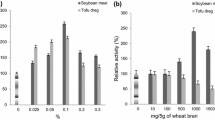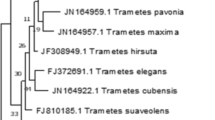Abstract
The aim of the present study was to investigate whether olive leaves were feasible as a substrate for laccase production by the white-rot fungus Trametes versicolor FPRL 28A INI under solid-state fermentation conditions. Different experiments were conducted to select the variables that allow obtaining high levels of laccase activity. In particular, the effects of the initial moisture content, substrate particle size, supplementation with inorganic and organic nitrogen sources were evaluated. Highest laccase activity (276.62 ± 25.67 U/g dry substrate) was achieved with 80 % initial moisture content and 1.4–1.6 mm particle size of the substrate supplemented with yeast extract (1 % (w/w) nitrogen). Such a high activity was obtained without any addition of inducers.





Similar content being viewed by others
References
Camarero S, Ibarra D, Martínez MJ, Martinez AT (2005) Lignin-derived compounds as efficient laccase mediators for decolorization of different types of recalcitrant dyes. Appl Environ Microbiol 71:1775–1784
Ergül FE, Sargın S, Öngen G, Sukan FV (2009) Dephenolisation of olive mill wastewater using adapted Trametes versicolor. Int Biodeterior Biodegr 63:1–6
Kalme S, Jadhav S, Jadhav M, Govindwar S (2009) Textile dye degrading laccase from Pseudomonas desmolyticum NCIM 2112. Enzyme Microb Technol 44:65–71
Rodríguez Couto S, Sanromán Á (2005) Coconut flesh: a novel raw material for laccase production by Trametes hirsuta under solid-state conditions. Application to Lissamine Green B decolourization. J Food Eng 71:208–213
Thurston CF (1994) The structure and function of fungal laccases. Microbiol 1994(140):19–26
Rodríguez Couto S, Moldes D, Liébanas A, Sanromán Á (2003) Investigation of several bioreactor configurations for laccase production by Trametes versicolor operating in solid-state conditions. Biochem Eng J 15:21–26
Roy JJ, Abraham TE, Abhijith KS, Kumar PV, Thakur MS (2005) Biosensor for the determination of phenols based on crosslinked enzyme crystals (CLEC) of laccase. Biosens Bioelectron 21:206–211
Xiao YZ, Tu XM, Wang J, Zhang M, Cheng Q, Zeng WY, Shi YY (2003) Purification, molecular characterization and reactivity with aromatic compounds of a laccase from a basidiomycete. Trametes sp. strain AH28-2. Appl Microbiol Biotechnol 60:700–707
Soden DM, Dobson ADW (2004) Differential regulation of laccase gene expression in Pleurotus sajor-caju. Microbiol 14:1755–1763
Galhaup C, Goller S, Peterbauer CK, Strauss J, Haltrich D (2002) Characterization of the major laccase isoenzyme from Trametes pubescens and regulation of its synthesis by metal ions. Microbiol 148:2159–2169
Faraco V, Giardina P, Sannia G (2002) Metal-responsive elements in Pleurotus ostreatus laccase gene promoters. Microbiol 149:2155–2162
Baldrian P, Gabriel J (2002) Variability of laccase activity in the white-rot basidiomycete Pleurotus ostreatus. Folia Microbiol 47:385–390
Zhang H, Hong YZ, Xiao YZ, Yuan J, Tu XM, Zhang XQ (2006) Efficient production of laccases by Trametes sp. AH28-2 in cocultivation with a Trichoderma strain. Appl Microbiol Biotechnol 73:89–94
Osma JF, Toca Herrera JL, Rodríguez Couto S (2007) Banana skin: a novel waste for laccase production by Trametes pubescens under solid-state conditions. Application to synthetic dye decolouration. Dyes Pigm 75:32–37
Selvakumar P, Ashakumary L, Pandey A (1998) Biosynthesis of glucoamylase from niger by solid-state fermentation using tea waste as the basis of a solid substrate. Bioresour Technol 65:83–85
Gessesse A (1999) High-level xylanase production by an alkaliphilic Bacillus sp. by using solid state fermentation. Enzyme Microb Technol 25:68–72
Souza DF, Souza CGM, Peralta RM (2001) Effect easily metabolizable sugars in the production of xylanase by Aspergillus tamarii in solid state fermentation. Process Biochem 36:835–838
Murugesan K, Nam I, Kim Y, Chang Y (2007) Decolorization of reactive dyes by a thermostable laccase produced by Ganoderma lucidum in solid state culture. Enzyme Microb Technol 40:1662–1672
Gómez J, Pazos M, Rodríguez S, Sanromán A (2005) Chestnut shell and barley bran as potential substrate for laccase production by Coriolopsis rigida under solid-state conditions. J Food Eng 68:315–319
Rodríguez Couto S, Lorenzo MGM, Sanroman Á (2002) Screening of supports and inducers for laccase production by Trametes versicolor in semi-solid-state conditions. Process Biochem 38:249–255
Rodríguez Couto S, Sanromán Á (2006) Effect of two wastes from groundnut processing on laccase production and dye decolourisation ability. J Food Eng 73:388–393
Elisashvili V, Penninckx M, Kachlishvili E, Tsiklauri N, Metreveli E, Kharziani T, Kvesitadze G (2008) Lentinus edodes and Pleurotus species lignocellulolytic enzymes activity in submerged and solid-state fermentation of lignocellulosic wastes of different composition. Bioresour Technol 99:457–462
Rodríguez Couto S, Lopez E, Sanromán Á (2006) Utilisation of grape seeds for laccase production in solid-state fermenters. J Food Eng 74:263–267
Rosales E, Rodríguez Couto S, Sanromán MA (2005) Reutilisation of food processing wastes for production of relevant metabolites: application to laccase production by Trametes hirsuta. J Food Eng 66:419–423
Rosales E, Rodríguez Couto S, Sanromán MA (2007) Increased laccase production by Trametes hirsute grown on ground orange peelings. Enzyme Microb Technol 40:1286–1290
Benavente-García O, Castillo J, Lorente J, Ortuño A, Del Río JA (2000) Antioxidant activity of phenolics extracted from Olea europaea l. leaves. Food Chem 68:457–462
Ferrira ICFR, Barros L, Soares HE, Bastos HL, Pereira JA (2007) Antioxidant activity and phenolic contents of Olea europaea L. leaves sprayed with different copper formulations. Food Chem 103:188–195
Bouaziz M, Sayadi S (2005) Isolation and evaluation of antioxidants from leaves of a Tunisian cultivar olive tree. Eur J Lipid Sci Tech 107:497–504
Pereira AP, Ferreira ICFR, Marcelino F, Valentão P, Andrade PB, Seabra R, Estevinho L, Bento A, Pereira JA (2007) Phenolic compounds and antimicrobial activity of olive (Olea europaea L. Cv. Cobrançosa) leaves. Molecules 12:1153–1162
Sudjana AN, D’Orazio C, Ryan V, Rasool N, Ng J, Islam N, Riley TV, Hammer KA (2009) Antimicrobial activity of commercial Olea europaea (olive) leaf extract. Int J Antimicrobl Agents 33:461–463
Bisignano G, Tomaino A, Lo Cascio R, Crisafi G, Uccella N, Saija A (1999) On the in vitro antimicrobial activity of oleuropein and hydroxytyrosol. J Pharm Pharmacol 51:971–974
Markin D, Duek L, Berdicevsky I (2003) In vitro antimicrobial activity of olive leaves. Mycoses 46:132–136
Martín-García I, Yáñez-Ruiz DR, Moumen A, Molina-Alcaide E (2006) Effect of polyethylene glycol, urea and sunflower meal on olive (Olea europaea var. europaea) leaf fermentation in continuous fermenters. Small Ruminant Res 61:53–61
Molina Alcaide E, Yañez Ruiz DR, Moumen A, Martín García I (2003) Chemical composition and nitrogen availability for goats and sheep of some olive by-products. Small Ruminant Res 49:329–336
Official methods of analysis of the association of official analytical chemists (1990) Dry matter content. In: Helrich K (ed) AOAC Inc., USA. Method No. 920.15
Official methods of analysis of the association of official analytical chemists (1995a) Nitrogen in spices. In: Helrich K (ed) 16th edn. AOAC, Inc., USA. Method No. 920.165
Paquot C, Hautfenne A (1987) International union of pure and applied chemistry, standard methods for the analysis of oils, fats and derivatives. Blackwell Scientific Publications, Oxford, England. Method No: 1.122
Turkish Standards Institution (2003) Tea-determination of crude fibre content. Turkish Standards Institution, Ankara. 2003; TS ISO 15598
Official methods of analysis of the association of official analytical chemists (1995b) Ash of canned vegetables. In: Helrich K (ed) 16th edn. AOAC, Inc., USA. Method No. 925.051
Boudhrioua N, Bahloul N, Slimen IB, Kechaou N (2009) Comparison on the total phenol contents and the color of fresh and infrared dried olive leaves. Ind Crops Prod 29:412–419
Škerget M, Kotnik P, Hadolin M, Hraš AR, Simonic M, Knez Z (2005) Phenols, proanthocyanidins, flavones and flavonols in some plant materials and their antioxidant activities. Food Chem 89:191–198
Udayasoorian C, Prabu PC (2005) Biodegradation of phenols by ligninolytic fungus, Trametes versicolor. J Biol Sci 5:824–827
Tien M, Kirk TK (1984) Lignin-degrading enzymes from Phanerochaete chtysosporium: purification, characterization and catalytic properties of a unique H2O2-requiring oxygenase. Proc Natl Acad Sci 81:2280–2284
Kaşıkara Pazarlıoğlu N, Sariişik M, Telefoncu A (2005) Laccase: production by Trametes versicolor and application to denim washing. Process Biochem 40:1673–1678
Selvam K, Swaminathan K, Song MH, Chae KS (2002) Biological treatment of a pulp and paper industry effluent by Fomes lividus and Trametes versicolor. World J Microbiol Biotechnol 18:523–536
Mikiashvili N, Elisashvili V, Wasser S, Nevo E (2005) Carbon and nitrogen sources influence the ligninolytic enzyme activity of Trametes versicolor. Biotechnol Lett 27:955–959
Vogel HJ (1956) A convenient growth medium for Neurospora crassa. Genetic Bull 13:42–43
Palmieri G, Giardinai P, Bianco C, Scaloni A, Capasso A, Sannia GA (1997) Novel white laccase from Pleuroutus ostreatus. J Biol Chem 272:31301–31307
Pandey A, Selvakumar P, Soccol CR, Nigam P (1999) Solid state fermentation for the production of industrial enzymes. Curr Sci 77:149–162
Durand A (2003) Bioreactor designs for solid state fermentation. Biochem Eng J 13:113–125
Lu W, Li D, Wu Y (2003) Influence of water activity and temperature on xylanase biosynthesis in pilot-scale solid-state fermentation by Aspergillus sulphureus. Enzyme Microb Technol 32:305–311
Pandey A, Soccol CR, Rodriguez-Leon JA, Nigam P (2001) Solid-state fermentation in biotechnology—fundamentals and applications. Asiatech Publishers, New Delhi, pp 21–31
Bollag JM, Leonowicz A (1984) Comparative studies of extracellular fungal laccases. Appl Environ Microbiol 48:849–854
Swamy J, Ramsay JA (1999) The evaluation of white rot fungi in the decolouration of textile dyes. Enzyme Microbiol Technol 24:130–137
Revankar MS, Lele SS (2006) Enhanced production of laccase using a new isolate of white rot fungus WR-1. Process Biochem 41:581–588
Vikineswary S, Abdullah N, Renuvathani M, Sekaran M, Pandey A, Jones EBG (2006) Productivity of laccase in solid state fermentation of selected agro-residues by Pycnoporus sanguineus. Bioresour Technol 97:171–177
Mishra A, Kumar S (2007) Cyanobacterial biomass as N-supplement to agro-waste for hyper-production of laccase from Pleurotus ostreatus in solid state fermentation. Process Biochem 42:681–685
Acknowledgments
This work was supported by Ege University Research Fund (İzmir, Turkey, Project no: 009 MUH 008). The authors wish to thank Dr. Tajalli Keshavarz and Christine S. Evans (Westminster University, England) for kindly supplying the fungal strain.
Author information
Authors and Affiliations
Corresponding author
Rights and permissions
About this article
Cite this article
Aydınoğlu, T., Sargın, S. Production of laccase from Trametes versicolor by solid-state fermentation using olive leaves as a phenolic substrate. Bioprocess Biosyst Eng 36, 215–222 (2013). https://doi.org/10.1007/s00449-012-0777-2
Received:
Accepted:
Published:
Issue Date:
DOI: https://doi.org/10.1007/s00449-012-0777-2




